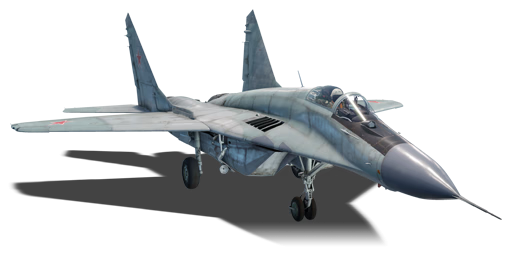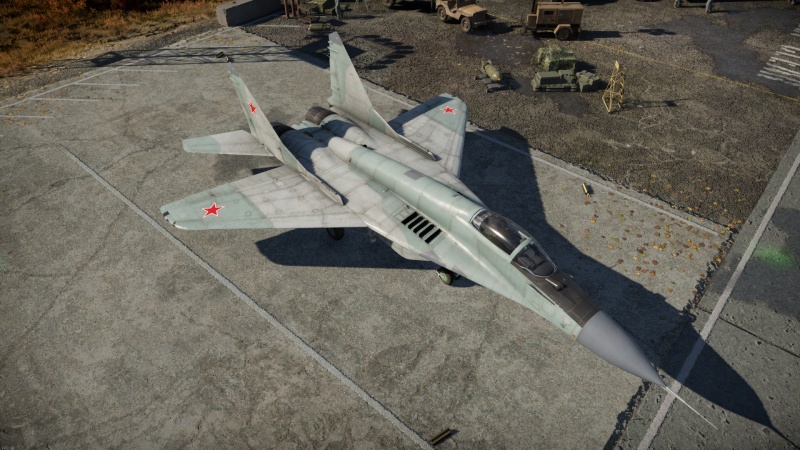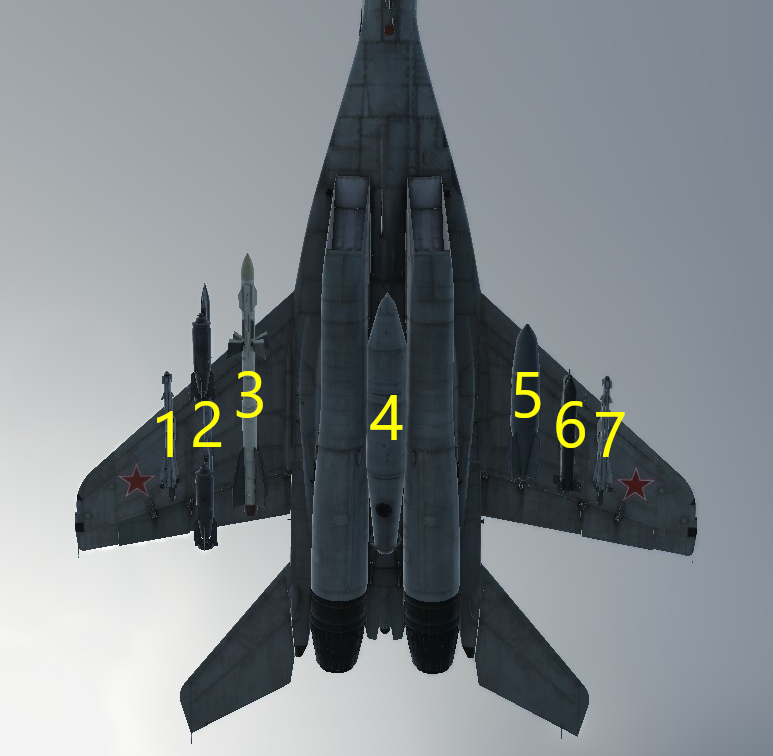MiG-29
Contents
Description
The MiG-29 (9-13) (NATO Code: Fulcrum-C; Izdeliye [Product] 9.13) is a rank VIII Soviet jet fighter with a battle rating of 12.7 (AB/RB/SB). It was introduced in Update "Apex Predators".
The first revision of the famous Strizhi (Swifts; nickname in Russian) family jet fighters, the MiG-29 offers a completely new style of combat, especially when the overall flight performance is vastly superior to the preceding MiG-23s with its light airframe and powerful jet engines, as well as new BVR missiles at its disposal.
General info
Flight performance
| Characteristics | Max speed (km/h at 14,000 m) |
Max altitude (metres) |
Turn time (seconds) |
Rate of climb (metres/second) |
Take-off run (metres) | |||
|---|---|---|---|---|---|---|---|---|
| AB | RB | AB | RB | AB | RB | |||
| Stock | 2,364 | 2,316 | 16000 | 20.2 | 20.3 | 275.7 | 262.5 | 750 |
| Upgraded | 2,549 | 2,452 | 19.0 | 19.6 | 368.1 | 320.0 | ||
Details
| Features | |||||
|---|---|---|---|---|---|
| Combat flaps | Take-off flaps | Landing flaps | Air brakes | Arrestor gear | Drogue chute |
| X | ✓ | ✓ | ✓ | X | ✓ |
| Limits | ||||||
|---|---|---|---|---|---|---|
| Wings (km/h) | Gear (km/h) | Flaps (km/h) | Max Static G | |||
| Combat | Take-off | Landing | + | - | ||
| 1,575 | 700 | N/A | 532 | 463 | ~10 | ~4 |
| Optimal velocities (km/h) | |||
|---|---|---|---|
| Ailerons | Rudder | Elevators | Radiator |
| < ___ | < ___ | < ___ | N/A |
Engine performance
| Engine | Aircraft mass | |||||
|---|---|---|---|---|---|---|
| Engine name | Number | Basic mass | Wing loading (full fuel) | |||
| Klimov RD-33 | 2 | 10,895 kg | ___ kg/m2 | |||
| Engine characteristics | Mass with fuel (no weapons load) | Max Gross Weight | ||||
| Weight (each) | Type | 8m fuel | 20m fuel | 28m fuel | ||
| 1,050 kg | Afterburning low-bypass turbofan | 11,901 kg | 13,241 kg | 14,248 kg | 18,408 kg | |
| Maximum engine thrust @ 0 m (RB/SB) | Thrust to weight ratio @ 0 m (WEP) | |||||
| Condition | 100% | WEP | 8m fuel | 20m fuel | 28m fuel | MGW |
| Stationary | 3,920 kgf | 6,816 kgf | 1.15 | 1.03 | 0.96 | 0.74 |
| Optimal | 5,430 kgf (1,575 km/h) |
12,445 kgf (1,575 km/h) |
2.09 | 1.88 | 1.75 | 1.35 |
Survivability and armour
Aside from the airframe and the alloy skin itself, the MiG-29 offers no extra protection to pilots or vital components; although the size is not the biggest among jets of its tier. Hits from cannon or missiles will very likely damage the jet beyond repair or taking down the pilot straight away. In case of a fire onboard, the Engine Fire System can save the jet and leave some thrust for a retreat or revenge kill.
Modifications and economy
Armaments
| Ballistic Computer | |||
|---|---|---|---|
| CCIP (Guns) | CCIP (Rockets) | CCIP (Bombs) | CCRP (Bombs) |
| |
|
|
|
Offensive armament
The MiG-29 is armed with:
- A choice between two presets:
- 1 x 30 mm GSh-30-1 cannon, cheek-mounted (150 rpg)
- 1 x 30 mm GSh-30-1 cannon + 60 x large calibre countermeasures
Suspended armament
The MiG-29 can be outfitted with the following ordnance presets:
- 1 x 1,500 l drop tank
- 2 x R-60M missiles
- 6 x R-60M missiles
- 6 x R-60 missiles
- 2 x R-27T missiles
- 2 x R-27R missiles
- 2 x R-27ER missiles
- 80 x S-8KO rockets
- 4 x S-24B rockets
- 16 x 100 kg OFAB-100 bombs (1,600 kg total)
- 4 x 250 kg FAB-250M54 bombs (1,000 kg total)
- 8 x 250 kg FAB-250M54 bombs (2,000 kg total)
- 4 x 250 kg FAB-250M-62 bombs (1,000 kg total)
- 8 x 250 kg FAB-250M-62 bombs (2,000 kg total)
- 4 x 500 kg FAB-500M-62 bombs (2,000 kg total) across 2 pylons
- 4 x 500 kg FAB-500M-62 bombs (2,000 kg total) across 4 pylons
- 4 x 500 kg FAB-500M-54 bombs (2,000 kg total) across 2 pylons
- 4 x 500 kg FAB-500M-54 bombs (2,000 kg total) across 4 pylons
- 4 x ZB-500 incendiary bombs
Custom loadout options
| 1 | 2 | 3 | 4 | 5 | 6 | 7 | ||
|---|---|---|---|---|---|---|---|---|
| 100 kg OFAB-100 bombs | 4 | 4 | 4 | 4 | ||||
| 250 kg FAB-250M54 bombs | 1, 2 | 1, 2 | 1, 2 | 1, 2 | ||||
| 250 kg FAB-250M-62 bombs | 1, 2 | 1, 2 | 1, 2 | 1, 2 | ||||
| 500 kg FAB-500M-54 bombs | 1 | 1, 2 | 1, 2 | 1 | ||||
| 500 kg FAB-500M-62 bombs | 1 | 1, 2 | 1, 2 | 1 | ||||
| ZB-500 incendiary bombs | 1 | 1 | 1 | 1 | ||||
| S-8KO rockets | 20 | 20 | 20 | 20 | ||||
| S-24B rockets | 1 | 1 | 1 | 1 | ||||
| R-27ER missiles | 1 | 1 | ||||||
| R-27R missiles | 1 | 1 | ||||||
| R-27T missiles | 1 | 1 | ||||||
| R-60 missiles | 1 | 1 | 1 | 1 | 1 | 1 | ||
| R-60M missiles | 1 | 1 | 1 | 1 | 1 | 1 | ||
| 1,500 l drop tanks | 1 | |||||||
| Maximum permissible loadout weight: 3,050 kg Maximum permissible wing load: 1,525 kg Maximum permissible weight imbalance: 1,200 kg | ||||||||
Usage in battles
The MiG-29 has an unique flight character, it's engines consume much fuel thus the external fuel tank, getting rid of the external fuel tank will reduce drag and improve the performance of the aircraft, this is mostly done before engaging a target. But the engines also provide excellent thrust at a very wide range of speeds giving you enough power to engage in long-lasting dogfights. The aircraft is not equipped with variable wing sweep, which is not very noticeable. Only when flying at high speeds at lower altitudes will you begin to notice that the wings produce much lift. The MiG-29 has decent manoeuvrability at high and low speeds, the energy retention is not something to complain about either. The 30 mm guns have a high velocity, making it easy to aim at targets, and are much better than earlier Soviet aircraft. The missiles which are the most effective are the R-60M and R-27ER. The R-60M are very easy to flare off, and at its BR many people will dodge these missiles in a head-on fairly easily. But the R-27ER has some very effective performance, with an improved radar system this missile will rock the battlefield.
Pros and cons
Pros:
- Good maneuverability and high speed
- Effective gun and radar system
Cons:
- Underperforming IR missiles
- Hard to reach high Gs at high speeds making it hard to dodge radar missiles
History
As proxy wars between the Soviet Union and the USA went on in different battlefields where the latest jets of the era could have been shot down by first generation jets like the MiG-17 (J-5) or the MiG-19 (J-6) in Vietnam, the USAF started their development on the new F-X program to ensure the air superiority in future combats (resulting in the F-15 Eagle). To counter the possible superiority of the new jet, the Soviet Union also started their Perspektivnyy Frontovoy Istrebitel (lit. "Advanced Frontline Fighter"), a program for an equivalent to the F-X in 1969. But after some development between Soviet firms TsAGI and Sukhoi, since the need for another lightweight jet to counter USAF's Lightweight Fighter program and its resulting product F-16 Fighting Falcon in 1971 arose, VVS also called for an Perspektivnyy Lyogkiy Frontovoy Istrebitel (lit. "Advanced Lightweight Frontline Fighter") where the new jets would become the cornerstones at a 1:2 ratio. After the intensive developments in 1970s, Sukhoi came up with the famous Su-27 Flanker while Mikoyan came with the other famous jet in Warsaw Pact service: the MiG-29 Fulcrum.
Compared to its Sukhoi rival, the MiG-29 traded the advanced flight control system and range of Flankers (until the introduction of the MiG-29S and MiG-29SMT with additional fuel tanks) with its infamous agility over NATO jets. When they were first publicly shown in different occasions through the 1980s, they had already become the new export fighter of choice for Warsaw Pact countries and allied customers over most continents of this planet such as Peru, Libya, Eritrea, India etc. Most of the MiG-29s didn't join conflicts during the Cold War aside from Iraqi ones, where they had to fight Iranian jet fighters, then later the coalition of NATO forces. These jets were then seen in many conflicts up to this date, sometimes even facing other Soviet jets, including the MiG-29's "higher-end" rival: the Su-27 (Eritrea vs. Ethiopia).
Media
- Videos
See also
Links to the articles on the War Thunder Wiki that you think will be useful for the reader, for example:
- reference to the series of the aircraft;
- links to approximate analogues of other nations and research trees.
External links
| Mikoyan-Gurevich Design Bureau (Микоя́н и Гуре́вич Опытное конструкторское бюро) | |
|---|---|
| Fighters | MiG-3-15 · MiG-3-15 (BK) · MiG-3-34 |
| I-225 | |
| Jet fighters | MiG-9 · MiG-9 (l) |
| MiG-15 · MiG-15bis · MiG-15bis ISh | |
| MiG-17 | |
| MiG-19PT | |
| MiG-21F-13 · MiG-21PFM · MiG-21S (R-13-300) · MiG-21SMT · MiG-21bis | |
| MiG-23M · MiG-23ML · MiG-23MLD | |
| MiG-27M · MiG-27K | |
| MiG-29 · MiG-29SMT | |
| Export/Licensed | ␗MiG-9 · ␗MiG-9 (l) |
| ◊MiG-15bis · ◔MiG-15bis · J-2* | |
| MiG-17AS · ◔MiG-17PF · J-4* · Shenyang F-5* | |
| ◊MiG-19S · J-6A* | |
| ◄MiG-21 SPS-K · ◊MiG-21MF · ◔MiG-21MF · ▄MiG-21bis · ◔MiG-21bis-SAU · ◊MiG-21bis-SAU · ◊MiG-21 "Lazur-M" · ▄MiG-21 Bison · J-7II** | |
| ◊MiG-23BN · ◊MiG-23MF · ◔MiG-23MF · ◊MiG-23MLA | |
| ◔MiG-29 · ◊MiG-29 · ◄MiG-29G | |
| *Licensed and domesticated with Chinese designations. | |
| **Unlicensed, reverse-engineered and domesticated with Chinese designations. | |
| See Also | Shenyang · Chengdu |
| USSR jet aircraft | |
|---|---|
| Bereznyak-Isayev | BI |
| Yakovlev | Yak-15 · Yak-15P · Yak-17 · Yak-23 · Yak-28B · Yak-30D · Yak-38 · Yak-38M · Yak-141 |
| Mikoyan-Gurevich | MiG-9 · MiG-9 (l) · MiG-15 · MiG-15bis · MiG-15bis ISh · MiG-17 · MiG-17AS · MiG-19PT |
| MiG-21F-13 · MiG-21PFM · MiG-21S (R-13-300) · MiG-21SMT · MiG-21bis | |
| MiG-23M · MiG-23ML · MiG-23MLD · MiG-27M · MiG-27K | |
| MiG-29 · MiG-29SMT | |
| Lavochkin | La-174 · La-15 · La-200 |
| Sukhoi | Su-9 · Su-11 |
| Su-7B · Su-7BKL · Su-7BMK · Su-17M2 · Su-17M4 · Su-22M3 | |
| Su-24M | |
| Su-25 · Su-25BM · Su-25K · Su-25T · Su-25SM3 · Su-39 | |
| Su-27 · Su-27SM | |
| Su-34 | |
| Ilyushin | IL-28 · IL-28Sh |
| Tupolev | Tu-14T |






